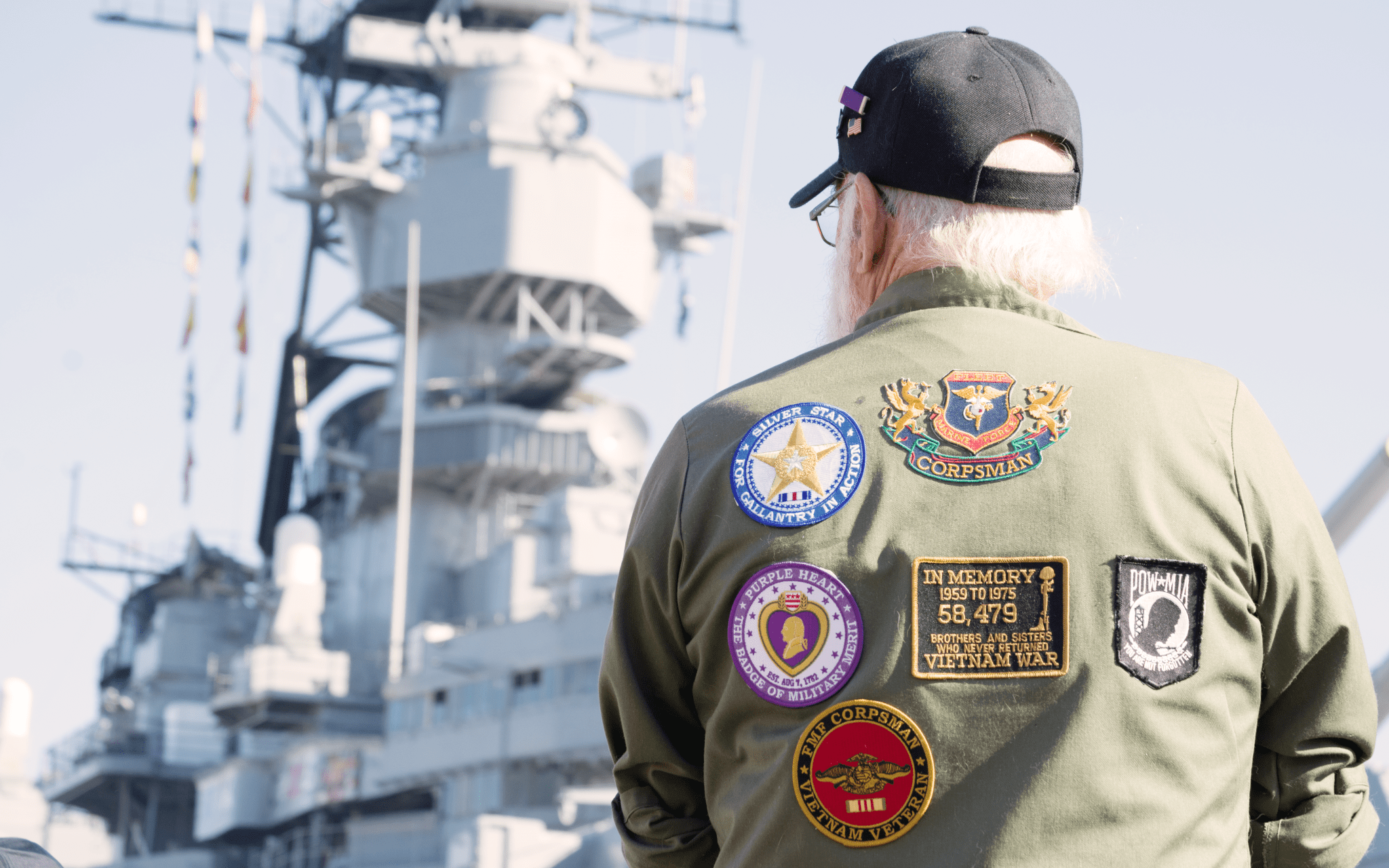Mesothelioma and U.S. Veterans
The U.S. military was one of the largest users of asbestos during the 20th century. As a result, veterans face an increased risk of developing mesothelioma (a rare cancer caused by asbestos exposure).

Why Do Veterans Get Mesothelioma?
Veterans and their families work to serve our country, yet thousands suffer devastating effects from their time served. If you or a loved one became ill due to your time served, we empathize with the feelings you are experiencing. United States Veterans account for nearly one-third of mesothelioma patients. For decades, the Military used asbestos in buildings, vehicles, and tools, affecting Veterans of the Army, Air Force, Navy, Marine Corps, Coast Guard, some families, and others who lived on or around military bases.
Usually, the latency period between exposure to toxic asbestos dust and the onset of cancer symptoms is about 38.4 years. Subsequently, many Veterans diagnosed with mesothelioma today were first exposed to airborne carcinogens decades earlier.
Veterans of World War II generally have the highest risk for asbestos-related cancers due to the large amounts of the material used by every branch. In addition, rates of mesothelioma reached a critical high point from the 1970s to the 1990s and have only leveled off slightly since that time. Consequently, researchers suggest that many servicemembers still face significantly higher risks from asbestos than the general population.
Mesothelioma and Asbestos Exposure by Military Branch
In most cases, certain job settings and locations exposed Veterans to dangerous, airborne asbestos particles while working during their service. A maintenance mechanic, for instance, may have inhaled asbestos dust from grinding machine components. Likewise, Veterans who worked on or near shipyards face the same risk.
Unfortunately, using asbestos in military buildings, barracks, dining halls, and more contributed to many toxic exposures between 1930 and 1980. As such, active duty, reserve, and National Guard members were at risk of developing long-term, asbestos-related conditions.
Military careers with historically high rates of asbestos exposure and disease include:
- Brake mechanics
- Carpentry/craftsmen
- Construction
- Demolition workers
- Electricians
- Insulators
- Longshoremen
- Machine maintenance
- Milling
- Petroleum and chemical workers
- Pipefitters
- Plumbers
- Powerhouse and utility workers
- Navy personnel
- Shipyard workers
- Vehicle repair
Veterans of foreign wars are also at high risk for respiratory problems related to their military service. Because people worldwide use asbestos, heavy construction and structurally damaged areas can release large amounts of asbestos particles into the air. As a result, soldiers in these areas may have inhaled or swallowed the toxic dust. Over time, they may notice a change in their breathing ability, chest pain, and fatigue.
Veterans with mesothelioma can take action without affecting their benefits.

US Army Asbestos Exposure
In the twentieth century, many buildings, ground transportation, and aircraft built for the US Army contained asbestos. Because of its fire-resistant nature, people used the mineral as insulation and incorporated it into cement, flooring, roofing, mastics, plumbing, and more. Additionally, mechanics used the material to line vehicle gaskets and brake systems.
While the Army closed many asbestos-contaminated buildings in the 1990s, those that remained open underwent repairs and remodeling. When not handled correctly, these activities risk exposing a new generation of soldiers to the mineral’s carcinogenic effects.
Army Veterans who worked in the following fields have a higher risk of developing mesothelioma:
- Aircraft Mechanic
- Artilleryman
- Infantryman
- Vehicle Mechanic
- Shipyard Workers
- Engineers
- Electricians
- Demolition Crews
Air Force Asbestos Exposure
During World Wars I and II, the Air Force was part of the US Army. Then, the branch expanded rapidly during World War II into its own department in 1947. During the same time, the Military used asbestos extensively on bases and in military vehicles and aircraft. For example, mechanics used asbestos-laden materials in aircraft brake systems, engine valves, and gaskets. As a result, high levels of carcinogenic materials continuously exposed many Airmen.
Air Force Veterans most at risk of developing mesothelioma may have worked in the fields of:
- Aircraft Handling
- Aircraft Mechanics
- Electrical Systems Specialization
- Environmental Systems Specialization
- Fire Control Technician
- Metalsmithing
Navy and Coast Guard Asbestos Exposure
More so than the other branches, Navy and Coast Guard Veterans face a significantly heightened risk of developing mesothelioma. According to a 1979 letter from the Department of the Navy, Office of the Chief of Naval Operations Ships, construction vessels used asbestos so commonly to construct vessels that it was “nearly impossible to build a Navy ship free of the mineral.”
When crew members needed to repair contaminated areas of Navy and Coast Guard vessels, many people inadvertently released crumbled asbestos fibers into the air. The poor ventilation of ships and submarines resulted in higher concentrations of inhalable asbestos.
Navy and Coast Guard Veterans most at risk of developing long-term occupational diseases:
- Boatswain’s Mate
- Damage Controlman
- Electrician’s Mate
- Fire Control Technician
- Gunner’s Mate
- Hull Maintenance Technician
- Machinery Repairman
- Machinist’s Mate
- Marine Inspectors
- Metalsmith
- Pipefitter
- Radioman
- Seabee
- Water Tender
- Welder
- Cutters
Marine Corps Asbestos Exposure
Many Marines experienced toxic exposure to dust and chemicals on Navy ships and Navy shipyards. In addition, dining halls, barracks, and boiler and engine rooms contained asbestos on many bases and outposts. Fort Ord in California, New River Air Station in North Carolina, North Carolina’s Camp LeJeune, Hawaii, Japan, Korea, and Vietnam are some of the most prevalent locations that exposed Marine Corps personnel to asbestos.
Marine Corps Veterans most at risk of developing mesothelioma include:
- Marines on Navy Ships
- Mechanics
- Construction Workers
- Pipefitters
- Demolition Crews
- Maintenance Workers
Secondhand Asbestos Exposure in Military Dependents and Families
Secondhand asbestos exposure occurs most often when an individual carries the dust home on clothes, shoes, hair, and skin. In addition, the dust particles may have been transferred to the carpet, furniture, or another person at home through direct contact. Over time, family members experienced increasing amounts of toxic exposure.
Also known as secondary or indirect exposure, it can be just as dangerous as working with asbestos directly. There is no safe level of asbestos exposure, and it can potentially cause illnesses like mesothelioma and asbestosis.
Veterans who were diagnosed with mesothelioma may be eligible for VA compensation. To find out if you qualify, speak with a patient advocate today.

How Was Asbestos Used in the Military?
The US military used asbestos for much of the 20th century. Asbestos has the unique ability to insulate and is fireproof, making it an excellent candidate for constructing Navy ships, tanks, aircraft, barracks, and other military-related builds. Unfortunately, the Military purchased asbestos materials from manufacturers who withheld information about the dangers of asbestos. This negligence put service members and even their families at risk. As a result of asbestos exposure, thousands of Veterans and their loved ones have developed asbestos-related conditions like mesothelioma and lung cancer. Learn about the unique ways the Military used asbestos and if you were exposed during your service.
Asbestos Exposure in Navy Ships and Shipyards
The US Navy used asbestos to construct ships and shipyards from the 1930s to the 1980s. During this time, the Military was unaware of the dangers that asbestos posed, but the US Navy eliminated the use of asbestos when its risks became known. Asbestos is not typically threatening when contained, but when its fibers become disturbed and loose, those inhaling or ingesting it may be at risk. Additionally, asbestos fibers can stick to items like clothing, skin, nails, or hair, and people can carry the fibers throughout a Naval ship.
Navy ships and shipyards no longer use asbestos, and the Military has removed it from most of the vessels and Navy Minesweepers used today. However, there are rare cases where active US Navy ships contain asbestos. The military claims the asbestos on these vessels is safely contained and does not pose a risk to servicemembers’ health. Additionally, because asbestos can be so difficult to remove and deadly, some Naval ships were left behind not to pose an additional risk to Veterans.
Asbestos Exposure in Barracks
The US Army used asbestos on bases and barracks from the 1930s to the early 1980s. Barracks utilized asbestos as it kept the grounds fireproof, durable, and insulated. Army barracks often used asbestos in:
- Cement
- Boiler rooms
- Construction materials
- Drywall
- Electrical wiring
- Gaskets
- Insulation
- Joint compound
- Piping
- Shingles
- Tile
- Other locations
Asbestos Exposure Overseas
During the 20th century, the US military used asbestos to construct its buildings, equipment, and vessels for insulation and fire-resistant properties. Asbestos particles exposed many Veterans, particularly those who traveled overseas.
Iraq, Afghanistan, Korea, Germany, and Vietnam are some of the most significant overseas military locations to expose Veterans to asbestos. Asbestos exposure in these locations may have occurred by working and living in buildings and ships with asbestos or during the demolition or bombing of asbestos-containing structures.
Compensation Options for Veterans Exposed to Asbestos
Many Veterans are also eligible for additional financial compensation from asbestos trust funds, personal injury cases, or wrongful death lawsuits. The plaintiffs will file against the asbestos companies and not against the US military or VA.
Servicemen and women who developed mesothelioma (or a related health problem) due to asbestos exposure can apply for these benefits directly through the Department of Veterans Affairs (VA). These include disability benefits, health care, compensation for medical expenses, and survivor benefits for family members (also called dependency or indemnity compensation). The organization determines eligibility on an individual basis.
VA Benefits
VA disability benefits provide health care and monetary compensation for service-related illnesses and injuries. To obtain benefits, you’ll need a current diagnosis of an asbestos-related disease recognized by the VA, your service records with a list of jobs or specialties, and a statement from a doctor linking your time in service to the health problem.
Options for filing a VA benefits claim:
- Apply online through eBenefits
- Contact a Veterans Service Organization or VA claims agent for assistance
- Visit a VA regional benefit office in your area
VA Disability Compensation
Disability compensation is one way Veterans can receive tax-free monetary benefits because of their disability. Two main compensations are dependency and indemnity compensation and special monthly compensation. Dependency and indemnity compensation is for family members or spouses of a military member who died while on active duty or active duty for training. The VA may grant special monthly compensation as an additional monthly salary given to veterans, parents, and spouses of active-duty military members who died on duty. Other benefits include housing grants, service disability Veterans’ insurance, and Veterans’ mortgage life insurance.
VA Pension
Some Veterans may qualify for a VA pension, a form of monetary compensation. For example, asbestos-exposed Veterans may qualify for this type of monetary compensation. To be eligible for a VA pension, there is a list of things you must fall under, including age and disability requirements. In addition, before filing for a pension, you must not have been dishonorably discharged, and your yearly family income must meet the limits set by Congress. For more information about if you qualify for VA pension benefits, visit the United States Department of Veterans Affairs website.
Special Monthly Compensation (SMC)
Special monthly compensation (SMC) is a form of compensation that the VA awards to Veterans, their spouses, or their families, typically of higher value than other forms. The SMC depends on a Veteran’s disability, and the rates are different because of this. Veterans with mesothelioma due to asbestos exposure at their old jobs are eligible for this compensation.
Asbestos Trust Funds
The judicial system formed asbestos trust funds because of the need to pay out large amounts of asbestos-related lawsuits. Large companies that unknowingly exposed their employees to toxic levels of asbestos faced bankruptcy because they had to pay out the cases. Asbestos trust funds were established to ensure companies had money to pay for the damages they had done to people. If you are a Veteran who believes you were exposed to asbestos due to your employer’s negligence, you should consider filing a claim for asbestos trust fund money.
Mesothelioma Lawsuits
Veterans comprise one of the largest groups of people likely to contract mesothelioma. Unfortunately, since mesothelioma takes up to 60 years to show signs of the disease, some Veterans aren’t aware they have it until it’s too late. Asbestos-exposed Veterans have two options when filing for a mesothelioma class action lawsuit: personal injury lawsuits or wrongful death claims. A statute of limitations differs in every state, so act fast in filing your case before it is too late.
Mesothelioma Settlements
It is a disheartening diagnosis for someone who is finding out they have mesothelioma. However, we are here to inform you of your options regarding receiving monetary compensation for your unlawful exposure. There are three types of mesothelioma settlements: a Veteran or loved one can file for an asbestos trust fund, a personal injury claim, or a wrongful death claim. Each of these has its own filing process and qualifications.
Veterans with mesothelioma can take action without affecting their benefits.

Cancer Treatment Centers for Veterans with Mesothelioma
Veterans and their loved ones can receive cancer treatment focused on mesothelioma through the VA. Additionally, the VA may cover common veteran cancer center treatment through VA benefits and insurance. It is important to perform your own research and discuss with your medical doctor where you should receive mesothelioma treatment.
Atlanta VA Health Care System
The Atlanta VA Health Care System is one of the best medical cancer facilities to treat Veterans with cancer, including mesothelioma. They partner with Emory University to provide Veterans with mesothelioma and other cancer treatment options, including doctors in thoracic surgery, medical oncology, and radiation oncology, as well as new clinical trials that aim to find new treatment options. In addition, each patient will receive a specialized treatment plan catered to each individual’s specific cancer outlook. The Atlanta VA Medical Center and its mesothelioma treatment options allow Veterans to feel hopeful about their diagnosis.
Michael E. DeBakey VA Medical Center
Located in Houston, Texas, the Michael E. DeBakey VA Medical Center is home to various treatment options for Veterans with mesothelioma. With doctors specializing in thoracic surgery, critical care, oncology, radiation oncology, and pathology, there is no limit to talented doctors taking care of you. In addition, Baylor College works with the medical center to perform clinical trials focusing on drugs and therapies being researched for their role in treating mesothelioma. With the combination of doctors studying mesothelioma at Micheal E. DeBakey VA Medical Center and Baylor College, you can be assured that your care is their utmost priority.
VA Boston Healthcare System
The VA Boston Healthcare System comprises three medical centers and five clinics in and around Boston, Massachusetts. One of the larger VA healthcare systems, they serve around 60,000 people annually between locations. Although you can receive mesothelioma advice and care in all areas, the Jamaica Plain and Brockton medical centers focus on invasive care. Those options may include surgery, radiation therapy, chemotherapy, or removal of fluid build-up. With each patient receiving a tailored treatment plan, the Boston VA Healthcare system prides itself in using a multimodal approach, including doctors of multiple areas and specialties. This allows them to provide the best possible care for mesothelioma Veterans.
VA Greater Los Angeles Healthcare System
With locations in Los Angeles and its surrounding suburbs, the VA Greater Los Angeles Healthcare System sees almost 90,000 Veterans yearly concerning their mesothelioma diagnoses. Unfortunately, California has a high number of Veterans with mesothelioma, majorly in part due to the 20 shipyards on its coasts being full of asbestos. Those working on or repairing Navy shipyards unknowingly exposed themselves to asbestos between 1930 and 1980; now, some have found out they have mesothelioma. With a skilled team of doctors and specialists, the Greater Los Angeles VA works to make mesothelioma care accessible to everyone affected by the disease. By enrolling in VA health care, you can have access to all the healthcare systems have to provide.
Orlando VA Medical Center
Servicing over 100,000 people in the area of Orlando and surrounding areas, the Orlando VA Medical Center and its ten clinics can take care of a large group of Veterans affected by mesothelioma and other related diseases. A group of doctors from multiple different areas of specialties combines forces to offer a well-rounded treatment plan, which includes options for the patients to choose from. In addition, these patient-oriented facilities give the best care possible no matter the circumstances.
Albany Stratton VA Medical Center
One of the leading facilities for mesothelioma care, the Albany Stratton VA Medical Center collaborates with multiple other institutions to create accessible healthcare, research, and education for Veterans. The facility aims to give quality healthcare by finding a diagnosis and sticking together through the final treatment stages and timeline. The staff of 100 medical doctors and 50 surgeons is dedicated to helping its Veteran community.
Shipyard Asbestos Exposure – Veterans Mesothelioma Cancer Risk
Shipyard workers are at a higher risk for asbestos exposure and mesothelioma development. This is because shipyards widely used asbestos until the late 1970s for pipes, boilers, and other equipment. As a result, shipyard workers may have been exposed to asbestos while building, repairing, or maintaining when asbestos fibers were released. When people release asbestos fibers, exposure can occur through inhalation, ingesting fibers, or direct contact with the asbestos-containing materials. Some of the most significant asbestos shipyards include the Norfolk Naval Shipyard, the Puget Sound Naval Shipyard, the Philadelphia Naval Shipyard, and many others.
Bethlehem Steel in Staten Island
The US military formed Bethlehem Steel in 1895, and they constructed wooden vessels, steel ships, and a foundry. In addition, the Military built destroyers, landing crafts, cargo vessels, and ocean tug boats for use in World War II. The workers here were exposed to asbestos products daily during the construction of ships and clean-up each day. The Military used asbestos cloth in this shipyard, which was given to workers to kneel on to protect them from the hot temperatures. There were other exposures to asbestos fibers with those working around boilers, which, at the time, the parts were being manufactured with asbestos in them.
The Brooklyn Shipyard
The Navy established the Brooklyn Navy Yard in 1801 and remained active until 1966 when it sold it to the City of New York. At the peak of its warship manufacturing, it held 70,000 workers. Many products and equipment contained asbestos, which unknowingly exposed their large workforce. Those items included valves, gaskets, boilers, insulation, fireproof materials, and clothing. Workers frequently found around boilers and insulation are at high risk for contracting mesothelioma, asbestosis, and other asbestos-related diseases. Since many asbestos items existed throughout the facility, Brooklyn shipyard workers were likely exposed to asbestos.
Tampa Bay Shipbuilding Company
Founded in 1917, the Tampa Bay Shipbuilding Company was a building and repair yard. It built several ships during WWI and WWII and employed over 16,000 individuals at its busiest time. Over time, the shipyard became a significant builder of boats for the US Navy; however, it would end up bankrupt and tossed around multiple times before being renamed American Shipbuilding Company today. Those who worked at the shipyard between the 1930s and 1980s may have been exposed to asbestos. US Navy ships were known to have many parts which contained asbestos. Since many workers weren’t aware asbestos causes mesothelioma, they unknowingly were exposed over a long period without protection. Since asbestos was cheap during the height of its manufacturing, US Navy ships had an asbestos mandate until the 1980s.
San Diego Naval Shipyard
The Military built the San Diego Naval Shipyard in 1919 to repair ships. Today, it houses 60 Navy ships and 50 separate commands and holds around 48,000 employees. Those who worked at the shipyard in the early days were more than likely exposed to asbestos since the Navy has the highest exposure out of all of the military branches. Those working on ships without proper air circulation can have the highest exposure while working on or near the boiler room, engine room, and pipes. The increased exposure for these workers has led to many mesothelioma diagnoses.
Puget Sound Naval Shipyard in Bremerton
The Puget Sound Naval Shipyard was established in Washington state in 1891 and became the first dry dock and repair facility in the Northwest, which focused on working on the largest ships. This shipyard played a role in WWI and WWII by building many warships and repairing those that came back mangled from the war. At the conception of the shipyard, 1,000 employees were building the yard itself. By 1945, the workforce had ballooned to 32,500 people. Any workers at the Puget Sound Naval Shipyard were probably exposed to asbestos at one point or another. The history of the US military and asbestos stems back to when they purchased 43 percent of the world’s asbestos in 1910. That asbestos was used heavily in the construction of shipyards and thus exposed thousands of shipyard workers at Puget Sound and abroad. Today, veterans can seek treatment for lung diseases at the VA Puget Sound Health Care.
Frequently Asked Questions about Veterans and Mesothelioma
As a Veteran with mesothelioma, we are sure you have several questions about your diagnosis. You may also have been exposed while living on or around a military base and be worried about the development of mesothelioma or other asbestos-related condition. We understand the curiosity and the scariness of the unknown. Mesothelioma Vets aims to answer your pressing questions and provide educational resources.
Is Mesothelioma a VA Disability?
Yes, the VA does classify diseases from asbestos exposure as a disability. However, for it to be a VA disability, the exposure must have come during your work for the Military. Asbestos is part of a group of toxic chemicals that entered the air and may have been inhaled by military Veterans.
Can You File a VA Claim for Mesothelioma?
The VA does allow Veterans to file claims for asbestos exposure disability compensation. To file a claim, you must have had contact with asbestos while serving in the Military and not have been dishonorably discharged.
How Do You Prove Mesothelioma?
You must prove you have the disease to ensure you receive compensation for your mesothelioma diagnosis. By showing your medical records stating your condition, your job or specialty service records, and a doctor’s statement saying your diagnosis came from work-related exposure to asbestos. You must present all three to substantiate your file of disability claims.
How Much is Mesothelioma Compensation?
Each mesothelioma compensation amount you may receive monthly depends on multiple things, including how many children you have, if you are married, and your disability rating. The VA classifies each person’s disability rating separately depending on the severity of their service-connected condition.
Am I Suing the Military If I File Suit?
No, you are not suing the Military if you file a suit for asbestos exposure. Instead, Veterans often sue the independent companies who sold supplies to the Military to use in their various capacities. In most instances, the supplies used by the Military that contained asbestos were manufactured elsewhere, then shipped to military bases, housing, buildings, etc.


